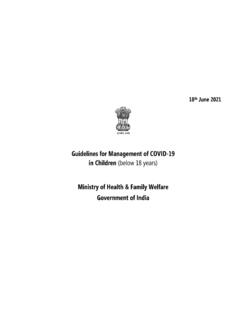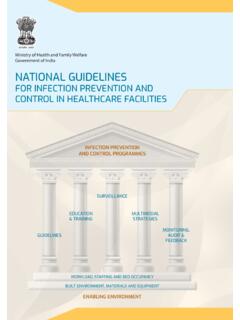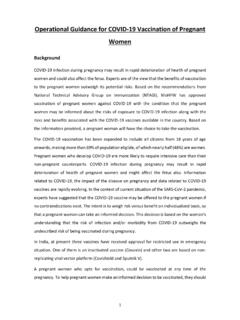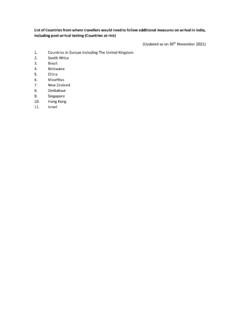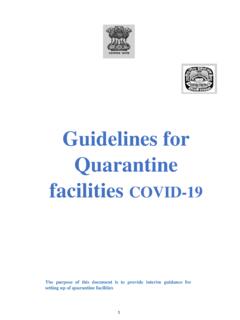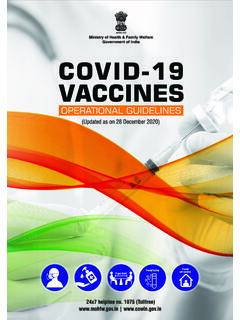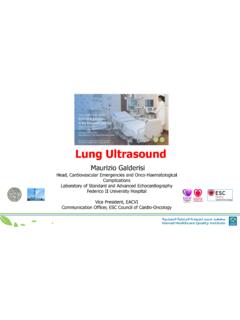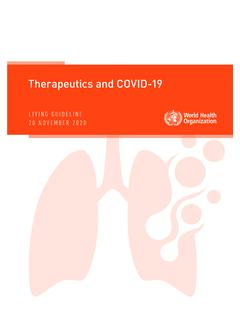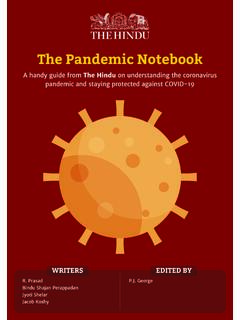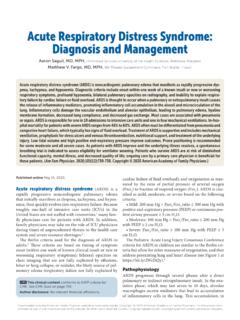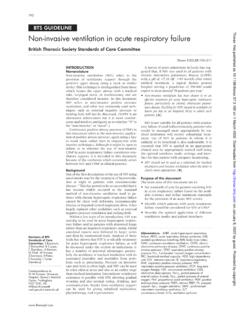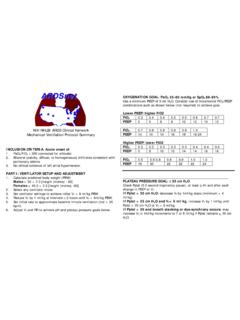Transcription of Revised Guidelines on Clinical Management of COVID 19
1 Government of India Ministry of Health & Family Welfare Directorate General of Health Services (EMR Division) Revised Guidelines on Clinical Management of COVID 19 This document is intended for clinicians taking care of hospitalised adult and paediatric patients of COVID 19. It is not meant to replace Clinical judgment or specialist consultation but rather to strengthen Clinical Management of these patients and provide to up-to-date guidance. Best practices for COVID - 19 including IPC and optimized supportive care for severely ill patients as considered essential. This document aims to provide clinicians with updated interim guidance on timely, effective, and safe supportive Management of patients with COVID - 19, particularly those with severe acute respiratory illness and critically ill.
2 31st March 2020 1 2 TABLE OF CONTENTS No. Topic Page No. 1 Case definitions 1 2 Clinical features 2 3 Immediate implementation of IPC measures 4 4 Laboratory diagnosis 6 5 Early supporting therapy and monitoring 8 6 Management of hypoxemic respiratory failure and ARDS 10 7 Management of septic shock 13 8 Other therapeutic measures 15 9 Prevention of complications 16 10 Specific therapy 18 When to suspect All symptomatic individuals who have undertaken international travel in the last 14 days or All symptomatic contacts of laboratory confirmed cases or All symptomatic healthcare personnel (HCP) or All hospitalized patients with severe acute respiratory illness ( SARI)
3 (fever AND cough and/or shortness of breath) or Asymptomatic direct and high risk contacts of a confirmed case (should be tested once between day 5 and day 14 after contact) Symptomatic refers to fever/cough/shortness of breath. Direct and high-risk contacts include those who live in the same household with a confirmed case and HCP who examined a confirmed case. 1. Case definition Confirmed case A person with laboratory confirmation of COVID -19 infection, irrespective of Clinical signs and symptoms 1 2 2. Clinical features COVID 19 may present with mild, moderate, or severe illness; the latter includes severe pneumonia, ARDS, sepsis and septic shock.
4 Early recognition of suspected patients allows for timely initiation of IPC (see Table 1). Early identification of those with severe manifestations (see Table 1) allows for immediate optimized supportive care treatments and safe, rapid admission (or referral) to intensive care unit . Table 1: Clinical syndromes associated with COVID - 19 infection Uncomplicated illness Patients with uncomplicated upper respiratory tract viral infection, may have non-specific symptoms such as fever, cough, sore throat, nasal congestion, malaise, headache. The elderly and immunosuppressed may present with atypical symptoms. Mild pneumonia Patient with pneumonia and no signs of severe pneumonia.
5 Child with non-severe pneumonia has cough or difficulty in breathing/ fast breathing: (fast breathing - in breaths/min): <2 months, 60; 2 11 months, 50; 1 5 years, 40 and no signs of severe pneumonia Severe pneumonia Adolescent or adult: fever or suspected respiratory infection, plus one of the following; respiratory rate >30 breaths/min, severe respiratory distress , SpO2 <90% on room air Child with cough or difficulty in breathing, plus at least one of the following: central cyanosis or SpO2 <90%; severe respiratory distress ( grunting, chest in- drawing); signs of pneumonia with any of the following danger signs: inability to breastfeed or drink, lethargy or unconsciousness, or convulsions.
6 Other signs of pneumonia may be present: chest indrawing, fast breathing (in breaths/min): <2 months 60; 2 11 months 50; 1 5 years 40. The diagnosis is Clinical ; chest imaging can exclude complications. acute respiratory distress syndrome Onset: new or worsening respiratory symptoms within one week of known Clinical insult. Chest imaging (radiograph, CT scan, or lung ultrasound): bilateral opacities, not fully explained by effusions, lobar or lung collapse, or nodules. 3 Origin of oedema: respiratory failure not fully explained by cardiac failure or fluid overload. Need objective assessment ( echocardiography) to exclude hydrostatic cause of oedema if no risk factor present.
7 Oxygenation (adults): Mild ARDS: 200 mmHg < PaO2/FiO2 300 mmHg (with PEEP or CPAP 5 cm H2O, or non-ventilated) Moderate ARDS: 100 mmHg < PaO2/FiO2 200 mmHg with PEEP 5 cm H2O, or non-ventilated) Severe ARDS: PaO2/FiO2 100 mmHg with PEEP 5 cm H2O, or non- ventilated) When PaO2 is not available, SpO2/FiO2 315 suggests ARDS (including in non- ventilated patients) Oxygenation (children; note OI = Oxygenation Index and OSI = Oxygenation Index using SpO2) Bilevel NIV or CPAP 5 cm H2O via full face mask: PaO2/FiO2 300 mmHg or SpO2/FiO2 264 Mild ARDS (invasively ventilated): 4 OI < 8 or 5 OSI < Moderate ARDS (invasively ventilated): 8 OI < 16 or OSI < Severe ARDS (invasively ventilated): OI 16 or OSI Sepsis Adults: life-threatening organ dysfunction caused by a dysregulated host response to suspected or proven infection, with organ dysfunction.
8 Signs of organ dysfunction include: altered mental status, difficult or fast breathing, low oxygen saturation, reduced urine output, fast heart rate, weak pulse, cold extremities or low blood pressure, skin mottling, or laboratory evidence of coagulopathy, thrombocytopenia, acidosis, high lactate or hyperbilirubinemia. Children: suspected or proven infection and 2 SIRS criteria, of which one must be abnormal temperature or white blood cell count Septic Shock Adults: persisting hypotension despite volume resuscitation, requiring vasopressors to maintain MAP 65 mmHg and serum lactate level < 2 mmol/L Children: any hypotension (SBP <5th centile or >2 SD below normal for age) or 2- 3 of the following: altered mental state; bradycardia or tachycardia (HR <90 bpm or >160 bpm in infants and HR <70 bpm or >150 bpm in children); prolonged 4 capillary refill (>2 sec) or warm vasodilation with bounding pulses; tachypnea.
9 Mottled skin or petechial or purpuric rash; increased lactate; oliguria; hyperthermia or hypothermia 3. Immediate implementation of appropriate IPC measures Infection prevention control (IPC) is a critical and integral part of Clinical Management of patients and should be initiated at the point of entry of the patient to hospital (typically the Emergency Department). Standard precautions should always be routinely applied in all areas of health care facilities. Standard precautions include hand hygiene; use of PPE to avoid direct contact with patients blood, body fluids, secretions (including respiratory secretions) and non-intact skin.
10 Standard precautions also include prevention of needle-stick or sharps injury; safe waste Management ; cleaning and disinfection of equipment; and cleaning of the environment. Table 2: How to implement infection prevention and control measures for patients with suspected or confirmed COVID - 19 infection At triage Give suspect patient a triple layer surgical mask and direct patient to separate area, an isolation room if available. Keep at least 1meter distance between suspected patients and other patients. Instruct all patients to cover nose and mouth during coughing or sneezing with tissue or flexed elbow for others.

